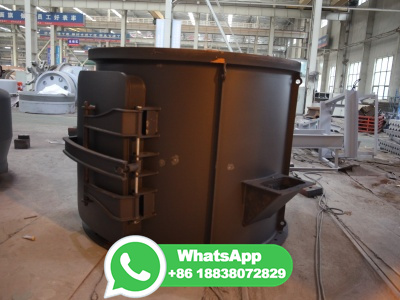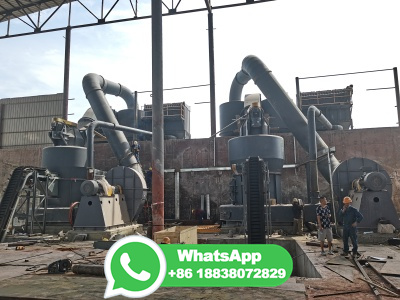
Due to global warming, technologies reducing CO2 emissions in the metallurgical industry are being sought. One possibility is to use biocoke as a substitute for classic coke made of 100% fossil coal. Biocoke can be produced on the basis of coal with the addition of substances of biomass origin. Blends for the production of biocoke should have appropriate cokemaking properties to ensure the ...
WhatsApp: +86 18838072829
This video is all about bio coal and the process of the same.#biocoal #biomass #biobriquettes #biofule#coal #charcoal #briquettes #development #Indiancoal#In...
WhatsApp: +86 18838072829
The world's largest steel manufacturer will deploy a pioneering technology to make its production greener and contribute to the circular carbon economy. A blast furnace uses coal to chemically reduce iron ore into iron, which is then further processed into steel. It releases large amounts of greenhouse gases CO and CO2 in the process.
WhatsApp: +86 18838072829
344 Chapter 9 Quality Control: Biochemistry and reproducibility (interlaboratory variability). Chapter 4 Metrology covers precision and the related term accuracy Purity assay: a quantitative analytical procedure used to determine the purity of the active product ingredient Purity method: a qualitative analytical procedure used to determine the purity of the active
WhatsApp: +86 18838072829
In pyrolysis, lignin, cellulose, and semicellulose, the main com ponents of biomass are quickly thermochemically decomposed in seconds to form smallmolecule compounds, in which about 50% of the volatiles can be condensed to form biooil. The carbon content of biooil ranges from 30 to 50%, and the high heating value (HHV) is about 15 MJ kg−1.
WhatsApp: +86 18838072829
The biocoal higher heating value (3032 MJ/kg) is in the range of the heating value of coal (3032 MJ/kg) used in the steel industries. Therefore, different biocoal production methods, such as pelletization, torrefaction, pyrolysis, hydrothermal carbonization, and steam explosion to produce biocoal, have been critically reviewed.
WhatsApp: +86 18838072829
Bioethanol production flowchart applications in transport sector Bioethanol is an environmentally friendly fuel for vehicles that normally run on petrol. As a renewable source of energy, it reduces demand on fossil fuels while it burns more cleanly and with reduced emissions of CO2, a greenhouse gas. As an energy source,
WhatsApp: +86 18838072829
A method for producing a biocoal includes the following steps: (a) lowering the moisture content of a fiber residue obtained after oil extraction of oil palm fruit to less than 25%; (b) after step (a), cutting the fiber residue; (c) after step (b), pelletizing the fiber residue into shortfiber pellets; (d) drying the shortfiber pellets to reduce the moisture content of the shortfiber ...
WhatsApp: +86 18838072829
coal, biocoal, oil, and natural gas decreased rapidly as a large number of manufacturing plants stopped production. This is one of the examples where we can see a decrease in demand. So, the analysis of the performance and reliability of biocoal manufacturing plants with deviation in demand is quite important to avoid nancial harm. Kenny
WhatsApp: +86 18838072829
Biomass briquettes are a biofuel substitute to coal and charcoal. Briquettes are mostly used in the developing world, where cooking fuels are not as easily available. There has been a move to the use of briquettes in the developed world, where they are used to heat industrial boilers in order to produce electricity from steam.
WhatsApp: +86 18838072829
Pyrolysis is a wellestablished thermochemical process that involves the thermal breakdown of biomass into various fuel components such as biochar, biooil and pyrolysis gas (A. V. Bridgwater, 2011). Biochar is a carbonaceous solid fuel which is considered an economical substitute for coal (Budarin et al., 2013; Cheng et al., 2020; Sakhiya et ...
WhatsApp: +86 18838072829
Coke corresponds to 2/33/4 of the reducing agents in BF, and by the partial replacement of coking coals with 510% of biocoal, the fossil CO2 emissions from the BF can be lowered by ~48%. Coking coal blends with 5% and 10% additions of biocoals (pretreated biomass) of different origins and pretreatment degrees were carbonized at laboratory scale and with a 5% biocoal addition at ...
WhatsApp: +86 18838072829
Abstract. The utilization of coal in the cement and concrete industries takes three basic forms: (1) as a fuel in the production of cement clinker; (2) ash produced by burning coal in power stations is used as a component in cement rotary kiln feeds; (3) ash produced by burning coal in power stations is used as a mineral additive in concrete ...
WhatsApp: +86 18838072829
It is an energyefficient process to produce a highenergy biocoal that burns clean and takes a few hours to produce [2,7,8]. Hydrothermal carbonization (HTC) is a thermochemical process that has received increasing attention. It accepts highmoisture biomass, which does not require an additional drying process prior to feeding, as raw ...
WhatsApp: +86 18838072829
Biomass briquetting is gradually emerging as a means of sustainable energy production. The interest in briquetting has been occasioned by the continuous rise in the cost of energy coupled with the need to harness efficient and affordable alternatives. Briquettes are produced through various means, ranging from a simple lowpressured technique to a highpressured technique. This, including the ...
WhatsApp: +86 18838072829
Next, the ability of the biocoal production process or HTC technology to reduce pollutants in the environment is also a key driver for the adoption of biocoal. The firms are keen to look for alternatives that can perform the same function as coal while being environmentally friendly, unlike conventional coal.
WhatsApp: +86 18838072829
economics of biomethanol production. • In the short term biomass could be cofed into a coalbased gasifier, or biogas fed into a natural gasbased methanol plant, so allowing for the gradual introduction of biomass as a feedstock and making methanol production more sustainable at a potentially lower cost. 4. Production costs of green e ...
WhatsApp: +86 18838072829
The liquefaction process had been performed in the range of 10 to 80 ml ethanol/g treated solid, and retention time ranges between 10 to 120 min., the produced biooil were extracted and separated ...
WhatsApp: +86 18838072829
Hong Kongbased SSGE BioEnergy is joining the green revolution by making bio coal as an alternative to the dirty fuel. ... The technology uses a process called torrefaction, which heats biomass ...
WhatsApp: +86 18838072829
Abstract Bioenergy, which originated from agricultural crop residue and industrial waste, has been studied for sustainable energy generation. As a raw material for briquettes production,...
WhatsApp: +86 18838072829
Biocoal properties such as bulk density and CV are comparable to bituminous coal, the primary energy source in thermal power plants [34]. Additionally, biocoal can be employed as a reactive reducing. Biocoal production technologies. Biocoal is a solid biofuel with properties comparable to conventional coal.
WhatsApp: +86 18838072829
January 6, 2020 report Making biocoal from plant waste to mitigate climate change by Bob Yirka, Credit: Grant Wilson/public domain A team of researchers affiliated with several...
WhatsApp: +86 18838072829
... [Show full abstract] PDF | Raw coal is still used as a primary fuel in brick plant in many developing countries. Coal is a nonrenewable source of energy and its use has... | Find, read...
WhatsApp: +86 18838072829
The production cost reflects the raw material cost, transportation, and energy consumption. Notably, wood biomass BioCokes can be used in cupola furnaces as an alternative to coal coke. The production process of wood biomass BioCokes is the same as that of BioCokes made from E. gracilis. The difference was in the first steps, whereas ...
WhatsApp: +86 18838072829
In this aspect, unutilized coal waste and sustainable biomass are considered major energy contributors to convert biomass blended coal fines as highquality solid briquettes. The present study integrates different briquette processing technologies to develop, coalbiomassbinder, coalbiomass (binderless), coalbinder, and carbonized biomass ...
WhatsApp: +86 18838072829
I. INTRODUCTION Bio coal is a form of fuel produced by drying chopped wood over a fire. Biomass Briquetting is the process of converting low bulk density biomass into high density and energy concentrated fuel briquettes. Biomass Briquetting machines are of various sizes which converts biomass into solid fuels.
WhatsApp: +86 18838072829
BioCoal Briquetting is the process of converting agro waste into high density and energy concentrated fuel briquettes also called as White Coal. It seems to be very good renewable fuel substitute. ... high net energy yield per hectare and low cost of production. These types of Shells are most favorably viewed, as it easily adapts to marginal ...
WhatsApp: +86 18838072829